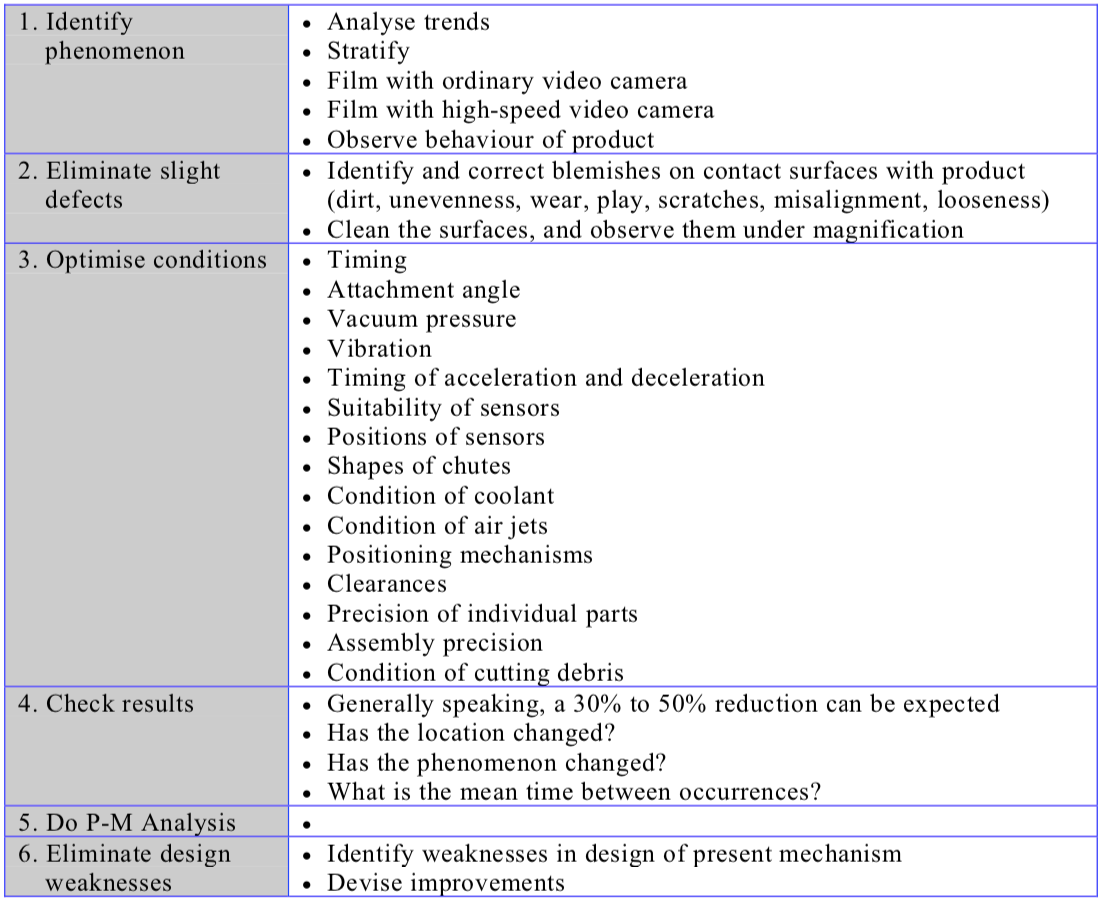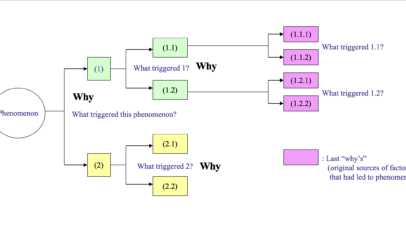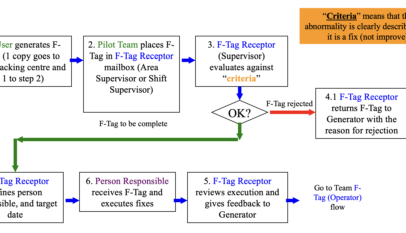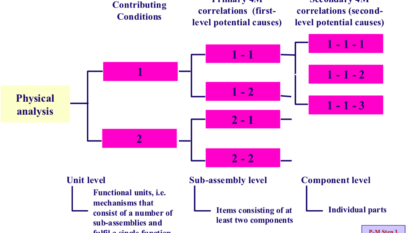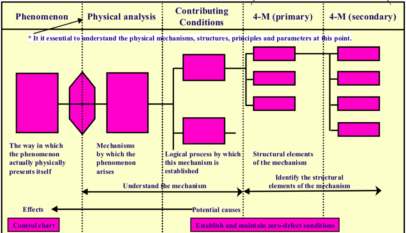(1) Analyze phenomenon and workpiece behaviour
Although the most important thing in reducing minor stops is to observe them actually happening, the opportunities for doing this are limited, making it difficult to devise precisely targeted remedial action. Phenomena should be videoed (using high-speed cameras for very fast minor stops) in order to obtain a correct understanding of the mechanism by which they occur. However, observing the workpieces or products even in the absence of a minor stop (their movement, orientation, angle, etc. and whether they bounce, ride up, vibrate and so forth) in order to identify patterns of behaviour is also helpful. Each action of the equipment (the timing and angle of its contact with the product, its speed of movement, shock, vibration, variability in stopping position, etc.) should also be closely observed. Even when the products and the equipment appear to be moving, in the same way, all the time, close observation will reveal subtle patterns that can shed light on the mechanism behind the phenomenon.
Observations like these should thus be used to elucidate the mechanism by which the minor-stop phenomenon occurs – theoretical explanations should be found for why the products move as they do, while subtle deficiencies in the way the machine performs each of its actions should be identified, and possible causes of those deficiencies in terms of the way the machine is constructed should be investigated.
To summarize, the minor stop phenomenon, the behaviour of the products, and the individual movements of the equipment should be observed in order to understand the mechanism producing a minor stop. Careful observation of the products and the equipment often enables the causes to be identified.
(2) Correct slight defects
Slight equipment defects are such a common cause of minor stops that the first thing to do in reducing the latter is to find and correct every slight defect on every part of the equipment that could possibly come into contact with the product. In some cases, a single slight defect causes a minor stop, while in others, a number of them act together. For example, when parts are supplied to a machine by an automatic parts feeder, there may be a very slight misalignment between the bowl and the chute, creating a small step at the point where the chute joins the bowl. Normally, this might not be a problem, but if some of the parts have small burrs on them, one of these could catch on the step, jamming the chute and causing a minor stop.
Spotting slight equipment defects entails detecting the subtlest of surface blemishes, which may require magnification, the development of new measurement techniques, sharpening the senses of the operators, or otherwise increasing the precision of observation and analysis. It is particularly important to establish clear standards of judgment for slight defects that cannot be quantified when the human senses afford the only means of discriminating between what is acceptable and what is not.
The following approaches should be used when searching for slight equipment defects because they will only be detected if the equipment and the materials that it processes are looked at in a new and different light:
- Search with an awareness of the problem in mind
- Compare the equipment in its present state with what it would be like if it were in perfect condition
- Treat as a defect anything that could reasonably give rise to suspicion
Finding and correcting slight equipment defects in the way described above can halve the rate of occurrence of minor stops and eliminate them from certain parts of the machine. This is why it is so important to spot and deal with even the tiniest blemish (including ones that are so slight as to make it very difficult to decide whether they could be called a defect or not) on any part of the equipment that could come into contact with the product.
The purpose behind correcting slight equipment defects is to minimize minor stops whose location and rate of occurrence change from day to day or from lot to lot. It reduces the number of possible causes and forces the minor stops to appear in a different guise (see Tables “Minor Stop Phenomena and their Possible Causes” and “The Kaizen Approach”).
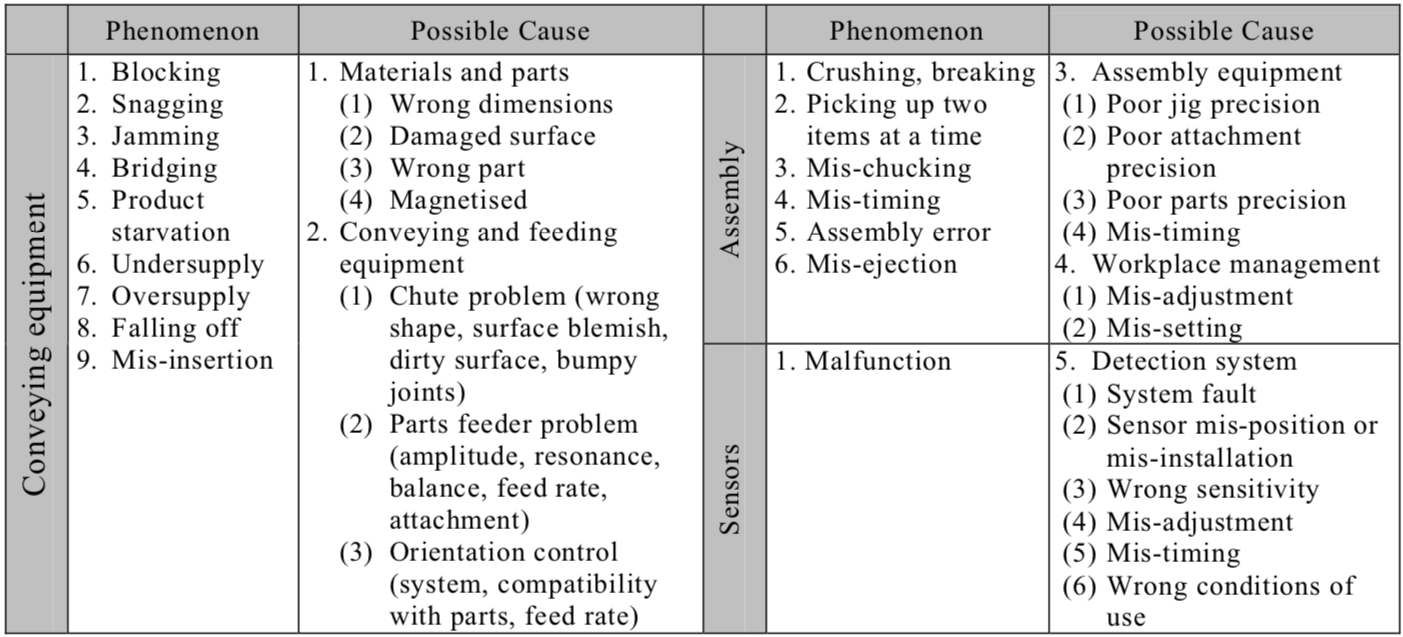
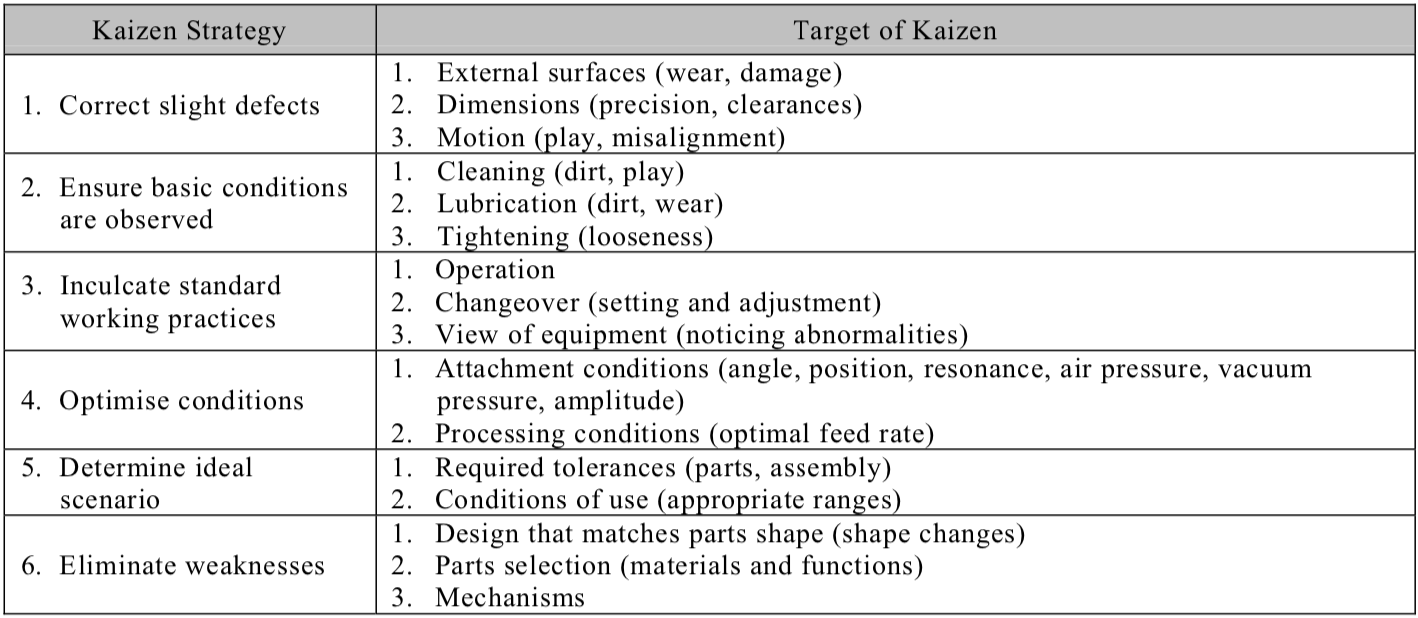
(3) Ensure that basic conditions are observed
In many cases, minor stops occur because basic workplace conditions (cleaning, lubricating and tightening) are not properly observed. Minor stops are inevitable if the equipment is never cleaned, is not properly lubricated, or slackness, play and vibration are left unchecked. Sustaining basic conditions must be integrated into the workplace culture in order to prevent this.
(4) Inculcate standard working practices
The rate of occurrence of minor stops is often affected by the way in which changeovers (including adjustments) are performed. Even the same operator can produce different results on different days depending on the quality of his or her work. This means that the methods used to set up and adjust the machines must be reviewed to ensure that they are correct; all too often, operators forget to do things the way they have been taught or believe they know a better way of doing it. A thorough review should be implemented to ensure that this does not happen.
Eliminating slight equipment defects and ensuring that basic equipment conditions and standard working practices are observed will alter the nature, location and frequency of minor stops but will not usually eliminate them. Further reductions require a deep analysis of the phenomenon.
(5) Optimize conditions
Before thinking about modifying equipment, jigs or tools, the processing conditions and the conditions under which the components and units have been installed should be reviewed. Processing conditions are physical characteristics such as air pressure, vacuum pressure, amplitude, feed rate and so on, while installation conditions include positions, angles, and resonance. Existing conditions will often simply have been set by extrapolation from those used in the past and may not necessarily be the best. They should be carefully reviewed, and the optimal conditions determined by trial and error or from the results of experiments and tests.
(6) Eliminate weaknesses
If minor stops fail to decrease even after the strategies described above have been applied, it is usually because there are problems with the design of the equipment, jigs, tools or detection systems used; for example, minor stops often occur when jigs are mismatched to the parts they are supposed to hold. Sometimes, minor stops occur because weaknesses in the design of the equipment are not recognized, or because the design of the equipment makes it very difficult for the operators to adjust it correctly. In cases like this, the design weaknesses must be accurately identified and corrective action is taken. Generally speaking, design problems are unique to individual products rather than applying to a range of different ones.
It is important to follow the preliminary steps of correcting slight defects, ensuring that basic conditions are observed and so on before modifying the equipment’s design. It is a mistake to start with design modification because problems are not usually due to design weaknesses on their own but rather to a combination of these with other factors that could be eliminated by restoring the equipment. If not removed, these other factors obscure the problem, making it impossible to identify the design weakness precisely.
Table “Procedure for Tackling Minor Stops” shows the procedure by which minor stops should be tackled.
